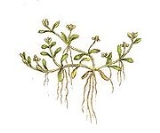
Elatinaceae
Encyclopedia
Elatinaceae is a family of flowering plant
s with 35-50 species in 2 genera: Elatine and Bergia. The Elatine are mostly aquatic herb
s, and the Bergia are subshrub
s to shrub
s. Elatine species are widely distributed throughout the world from temperate
to tropical zones, with its greatest diversity found in temperate zones. Bergia is found in temperate to tropical Eurasia
and Africa
, with two tropical and one tropical to temperate species in the Americas
. The center for biodiversity of Bergia is the Old World
tropics, and this is also the center for biodiversity for the family. Neither genus is found in arctic ecosystems.
Member of the family have bisexual flowers, usually small flowers, single, or in cyme
s, with two to five overlapping petal
s. The plants have opposite or whorled leaves, which may have glands along their margins, and have stipule
s. The aquatic herbs in the genus Elatine often have reduced characteristics as part of their adaptation to an aquatic habitat.
Waterwort (Elatine hexandra), a member of this family, and 2 similar species (Elatine hydropiper and Elatine macropoda) are often grown in aquarium
s.
http://cafe.naver.com/knowfreshwaterfish/54
Flowering plant
The flowering plants , also known as Angiospermae or Magnoliophyta, are the most diverse group of land plants. Angiosperms are seed-producing plants like the gymnosperms and can be distinguished from the gymnosperms by a series of synapomorphies...
s with 35-50 species in 2 genera: Elatine and Bergia. The Elatine are mostly aquatic herb
Herbaceous plant
A herbaceous plant is a plant that has leaves and stems that die down at the end of the growing season to the soil level. They have no persistent woody stem above ground...
s, and the Bergia are subshrub
Shrub
A shrub or bush is distinguished from a tree by its multiple stems and shorter height, usually under 5–6 m tall. A large number of plants may become either shrubs or trees, depending on the growing conditions they experience...
s to shrub
Shrub
A shrub or bush is distinguished from a tree by its multiple stems and shorter height, usually under 5–6 m tall. A large number of plants may become either shrubs or trees, depending on the growing conditions they experience...
s. Elatine species are widely distributed throughout the world from temperate
Temperate
In geography, temperate or tepid latitudes of the globe lie between the tropics and the polar circles. The changes in these regions between summer and winter are generally relatively moderate, rather than extreme hot or cold...
to tropical zones, with its greatest diversity found in temperate zones. Bergia is found in temperate to tropical Eurasia
Eurasia
Eurasia is a continent or supercontinent comprising the traditional continents of Europe and Asia ; covering about 52,990,000 km2 or about 10.6% of the Earth's surface located primarily in the eastern and northern hemispheres...
and Africa
Africa
Africa is the world's second largest and second most populous continent, after Asia. At about 30.2 million km² including adjacent islands, it covers 6% of the Earth's total surface area and 20.4% of the total land area...
, with two tropical and one tropical to temperate species in the Americas
Americas
The Americas, or America , are lands in the Western hemisphere, also known as the New World. In English, the plural form the Americas is often used to refer to the landmasses of North America and South America with their associated islands and regions, while the singular form America is primarily...
. The center for biodiversity of Bergia is the Old World
Old World
The Old World consists of those parts of the world known to classical antiquity and the European Middle Ages. It is used in the context of, and contrast with, the "New World" ....
tropics, and this is also the center for biodiversity for the family. Neither genus is found in arctic ecosystems.
Member of the family have bisexual flowers, usually small flowers, single, or in cyme
Inflorescence
An inflorescence is a group or cluster of flowers arranged on a stem that is composed of a main branch or a complicated arrangement of branches. Strictly, it is the part of the shoot of seed plants where flowers are formed and which is accordingly modified...
s, with two to five overlapping petal
Petal
Petals are modified leaves that surround the reproductive parts of flowers. They often are brightly colored or unusually shaped to attract pollinators. Together, all of the petals of a flower are called a corolla. Petals are usually accompanied by another set of special leaves called sepals lying...
s. The plants have opposite or whorled leaves, which may have glands along their margins, and have stipule
Stipule
In botany, stipule is a term coined by Linnaeus which refers to outgrowths borne on either side of the base of a leafstalk...
s. The aquatic herbs in the genus Elatine often have reduced characteristics as part of their adaptation to an aquatic habitat.
Waterwort (Elatine hexandra), a member of this family, and 2 similar species (Elatine hydropiper and Elatine macropoda) are often grown in aquarium
Aquarium
An aquarium is a vivarium consisting of at least one transparent side in which water-dwelling plants or animals are kept. Fishkeepers use aquaria to keep fish, invertebrates, amphibians, marine mammals, turtles, and aquatic plants...
s.
External links
- Elatinaceae in L. Watson and M.J. Dallwitz (1992 onwards). The families of flowering plants: descriptions, illustrations, identification, information retrieval. http://delta-intkey.com
http://cafe.naver.com/knowfreshwaterfish/54

